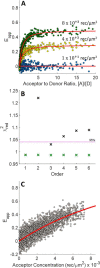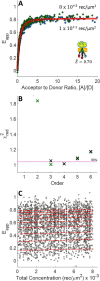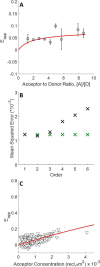Understanding the FRET Signatures of Interacting Membrane Proteins
- PMID: 28188294
- PMCID: PMC5392676
- DOI: 10.1074/jbc.M116.764282
Understanding the FRET Signatures of Interacting Membrane Proteins
Abstract
FRET is an indispensable experimental tool for studying membrane proteins. Currently, two models are available for researchers to determine the oligomerization state of membrane proteins in a static quenching FRET experiment: the model of Veatch and Stryer, derived in 1977, and the kinetic theory-based model for intraoligomeric FRET, derived in 2007. Because of confinement in two dimensions, a substantial amount of FRET is generated by energy transfer between fluorophores located in separate oligomers in the two-dimensional bilayer. This interoligomeric FRET (also known as stochastic, bystander, or proximity FRET) is not accounted for in either model. Here, we use the kinetic theory formalism to describe the dependence of the FRET efficiency measured in an experiment (i.e. the "total apparent FRET efficiency") on the interoligomeric FRET due to random proximity within the bilayer and the intraoligomeric FRET resulting from protein-protein interactions. We find that data analysis with both models without consideration of the proximity FRET leads to incorrect conclusions about the oligomeric state of the protein. We show that knowledge of the total surface densities of fluorophore-labeled membrane proteins is essential for correctly interpreting the measured total apparent FRET efficiency. We also find that bulk, two-color, static quenching FRET experiments are best suited for the study of monomeric, dimerizing, or dimeric proteins but have limitations in discerning the order of larger oligomers. The theory and methodology described in this work will allow researchers to extract meaningful parameters from static quenching FRET measurements in biological membranes.
Keywords: cell surface receptor; fluorescence resonance energy transfer (FRET); mathematical modeling; membrane biophysics; membrane protein.
© 2017 by The American Society for Biochemistry and Molecular Biology, Inc.
Conflict of interest statement
The authors declare that they have no conflicts of interest with the contents of this article
Figures











References
-
- Chung I., Akita R., Vandlen R., Toomre D., Schlessinger J., and Mellman I. (2010) Spatial control of EGF receptor activation by reversible dimerization on living cells. Nature 464, 783–787 - PubMed
-
- Sako Y., Minoghchi S., and Yanagida T. (2000) Single-molecule imaging of EGFR signalling on the surface of living cells. Nat. Cell Biol. 2, 168–172 - PubMed
MeSH terms
Substances
Grants and funding
LinkOut - more resources
Full Text Sources
Other Literature Sources

